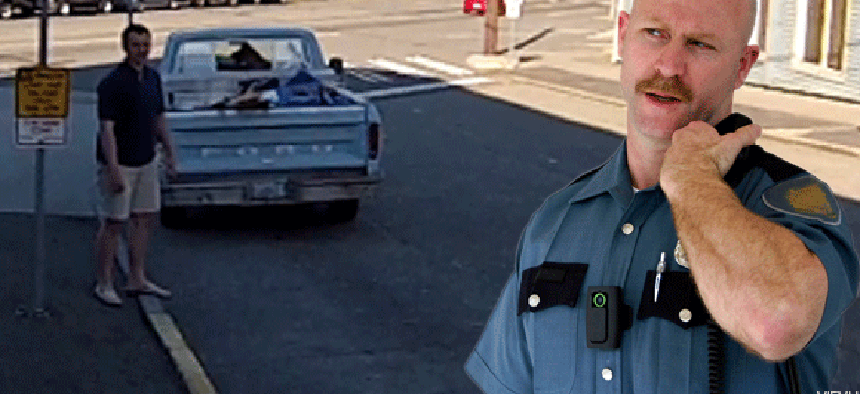Wearable camera for police gets video up close and personal


Connecting state and local government leaders
Lightweight wearable cameras gather high-quality video for police in Coeur d'Alene, Idaho, and a secure database on the back end provides evidence-grade management.
In 2010, the Coeur d’Alene, Idaho, Police Department began looking for a wearable video device for its officers to complement in-car video already in use. While in-car video is useful, it doesn’t get “up close and personal” or follow the officer when out of the car.
“How do you document a crime scene from an officer’s point of view?” asked Bill Tilson, administrative sergeant in charge of the department’s IT projects. “We were looking for something that was easy to use and worked from the officer’s point of view.”
Unfortunately, there were not a lot of viable solutions in 2010. Some were “promising very high and delivering very low,” Tilson said. Other cameras were too large and heavy to add to an officer’s uniform, and smaller ones offered poor video quality.
“And then there was VIEVU,” Tilson said. The company’s camera was small, lightweight (3.5 ounces), with a simple on-off switch and security that prevented video from being deleted by the officer. “That was another selling point,” Tilson said of the protection.
During a department beta test in 2012, an officer responding to a bank robbery turned on the camera, which recorded his response and take-down of the suspect. The video was used in a preliminary hearing to help get a guilty plea. “It was so easy and so good for us to have that,” Tilson said. Since then, all patrol officers and investigators in the 115-man force have gotten the cameras, which have been used in the investigations of several police shootings.
VIEVU was founded in 2007 by a former SWAT officer. Its wearable cameras are used in 3,100 police departments (about 90 percent of them in the United States), and by the end of 2013 they had recorded some 7 million hours of video.
“Public safety is pretty much our niche market,” said VIEVU president Steve Lovell.
The cameras themselves, though small, produce high quality video. The LE2 model used by Coeur d’Alene measures 3 inches by 2 inches and is .85 inches thick. It has a resolution of 640 by 480 pixels at 30 frames per second, 4 GB of internal memory and four hours recording time. The latest version, the LE3, is slightly lighter at 2.8 ounces, and it can produce high-definition video at 1280 x 720 pixels or a lower resolution of 848 x 480 to increase capacity.
It has 16 GB of internal memory for up to 12 hours of video storage, but recording time is limited to five hours by the battery.
Most police record just one to two hours of video a day, Lovell said, but when usage spikes, a “juice pack” plug-in battery pack is available to recharge the camera while in use.
Some of the most important features are on the back end. The VERIPATROL access controlled database lets officers upload video -- but not delete or alter it. There are no removable media in the camera, so video cannot be destroyed. Each camera is assigned to an officer and authenticates itself to the database through its firmware when connected.
The officer authenticates himself to the database using a user name and password to upload the day’s video. The video is digitally signed and can be annotated by the officer, but access is controlled by department policy. Specific files can be locked down to further restrict access, and files for active cases can be set to “never delete” to prevent their being purged at the end of the department’s retention period.
“Storage is a huge component,” of the system, Tilson said. His department is uploading about 17 GB of video a day, about 1 TB a month. “We are bolting storage on each year trying to keep it afloat. It’s a common problem that’s happening in law enforcement, as everything goes digital.”
Police departments already are being “hit with a wave of video,” Lovell said. Many departments already have in-car systems, interview room video, building security videos and video from suspect cell phones. “They usually have pretty strong strategies for hosting their video. Our video is one segment of it.”
Coeur d’Alene has an in-house digital evidence system for storage. Cloud storage is an option, but “we would rather have control of it ourselves,” to ensure that it meets standards for evidence in court, Tilson said.
However there are some tradeoffs to wearable video. First, it is yet one more piece of equipment to wear. “You ask us to put another two ounces on us, and we gripe about it,” Tilson said. “Some guys just don’t like it on them.”
And it is easy to become too dependent on the camera. If for any reason it isn’t used or doesn’t work, it opens the way for a challenge in court because, “if it isn’t on video, it didn’t happen.” Nonetheless, the advantages of the wearable police camera to date far outweigh the tradeoffs, he said.




